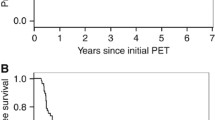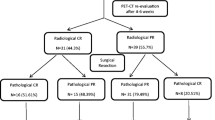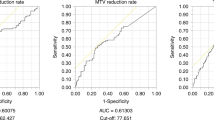Abstract
Purpose
FDG PET has been suggested to have predictive value in the prognosis of oesophageal carcinoma. However, the retrospective studies reported in the literature have shown discordant results. Additionally, only four studies have evaluated FDG PET during chemoradiotherapy (CRT) in patients with different histological lesions. The purpose of this study was to investigate the predictive value of FDG PET performed early during CRT (on day 21) in a population of patients with oesophageal squamous cell carcinoma.
Methods
Included in this prospective study were 57 patients with a histological diagnosis of squamous cell carcinoma of the oesophagus. Of these 57 patients, 48 (84 %) were evaluated (aged 63 ± 11 years; 44 men, 4 women). Each patient underwent FDG PET (4.5 MBq/kg) before CRT, according to the Herskovic protocol (t0; PET1) and on day 21 ± 3 from the start of CRT (d21; PET2). The response assessment included a clinical examination, CT scan or FDG PET and histological analysis 3 months and 1 year after PET1. The patients were classified as showing a complete response (CR) or a noncomplete response. A quantitative analysis was carried out for PET1 and PET2 using the following parameters: SUVmax, SUVmean (with SUVmean40 as the 3-D volume at an SUVmax threshold of 40 % and SUVmeanp as that defined by a physician), tumour volume (TV, with TV40 defined as the TV at 40 % of SUVmax, and TVp as that defined by a physician); and the total lesion glycolysis (TLG, SUVmean × TV, with TLG40 defined as the TLG at 40 % of SUVmax, and TLGp as that defined by a physician). The differences in responses at 3 months and 1 year between PET1 (t0) and PET2 (d21) were assessed in terms of variations in SUV, TV and TLG using a repeated measures of variance (ANOVA).
Results
SUVmax, SUVmean and TLG decreased significantly between PET1 (t0) and PET2 (d21; p < 0.0001). The TV significantly decreased only when assessed as TVp (p = 0.02); TV40 did not decrease significantly. With respect to the predictive value of PET1, only TV40_1 and TVp_1 values, and therefore TLG40_1 and TLGp_1, but not the SUV values, were significantly lower in patients with CR at 3 months. SUVmax1, TVp_1 and TLGp_1 were significantly lower in patients with CR at 1 year. With respect to the predictive value of PET2, only TV40_2 and TVp_2 values, and therefore TLG40_2 and TLGp_2, but not the SUV values, were significantly lower in patients with CR at 3 months. None of the PET2 parameters had significant value in predicting patient outcome at 1 year. The changes in SUVmax, TV40, TVp, TLG40 and TLGp between PET1 and PET2 had no relationship to patient outcome at 3 months or 1 year.
Conclusion
This prospective, multicentre study performed in a selected population of patients with oesophageal squamous cell cancer demonstrates that the parameters derived from baseline PET1 are good predictors of response to CRT. Specifically, a high TV and TLG are associated with a poor response to CRT at 3 months and 1 year, and a high SUVmax is associated with a poor response to CRT at 1 year. FDG PET performed during CRT on day 21 appears to have less clinical relevance. However, patients with a large functional TV on day 21 of CRT have a poor clinical outcome (ClinicalTrials.gov NCT 00934505).


Similar content being viewed by others
References
Keighley MR. Gastrointestinal cancers in Europe. Aliment Pharmacol Ther. 2003;18 Suppl 3:7–30. PubMed PMID: 14531737. Epub 2003/10/09. eng.
Enzinger PC, Mayer RJ. Esophageal cancer. N Engl J Med. 2003;349(23):2241–52. PubMed PMID: 14657432. Epub 2003/12/06. eng.
Courrech Staal EF, Aleman BM, Boot H, van Velthuysen ML, van Tinteren H, van Sandick JW. Systematic review of the benefits and risks of neoadjuvant chemoradiation for oesophageal cancer. Br J Surg. 2010;97(10):1482–96. PubMed PMID: 20645400. Epub 2010/07/21. eng.
Bedenne L, Michel P, Bouche O, Milan C, Mariette C, Conroy T, et al. Chemoradiation followed by surgery compared with chemoradiation alone in squamous cancer of the esophagus: FFCD 9102. J Clin Oncol. 2007;25(10):1160–8. PubMed PMID: 17401004. Epub 2007/04/03. eng.
Stahl M, Stuschke M, Lehmann N, Meyer HJ, Walz MK, Seeber S, et al. Chemoradiation with and without surgery in patients with locally advanced squamous cell carcinoma of the esophagus. J Clin Oncol. 2005;23(10):2310–7. PubMed PMID: 15800321. Epub 2005/04/01. eng.
Jones DR, Parker Jr LA, Detterbeck FC, Egan TM. Inadequacy of computed tomography in assessing patients with esophageal carcinoma after induction chemoradiotherapy. Cancer. 1999;85(5):1026–32. PubMed PMID: 10091784. Epub 1999/03/26. eng.
Cooper JS, Guo MD, Herskovic A, Macdonald JS, Martenson Jr JA, Al-Sarraf M, et al. Chemoradiotherapy of locally advanced esophageal cancer: long-term follow-up of a prospective randomized trial (RTOG 85-01). Radiation Therapy Oncology Group. JAMA. 1999;281(17):1623–7. PubMed PMID: 10235156. Epub 1999/05/11. eng.
Di Fiore F, Blondin V, Hitzel A, et al. 18F-Fluorodeoxyglucose-positron emission tomography after definitive chemoradiotherapy in patients with esophageal cancer. Dig Liver Dis. 2012;44(10):875–9.
Krause BJ, Herrmann K, Wieder H, zum Buschenfelde CM. 18F-FDG PET and 18F-FDG PET/CT for assessing response to therapy in esophageal cancer. J Nucl Med. 2009;50 Suppl 1:89S–96S. PubMed PMID: 19380406. Epub 2009/04/22. eng.
Ben-Haim S, Ell P. 18F-FDG PET and PET/CT in the evaluation of cancer treatment response. J Nucl Med. 2009;50(1):88–99. PubMed PMID: 19139187. Epub 2009/01/14. eng.
Weber WA. Use of PET for monitoring cancer therapy and for predicting outcome. J Nucl Med. 2005;46(6):983–95. PubMed PMID: 15937310. Epub 2005/06/07. eng.
Barber TW, Duong CP, Leong T, Bressel M, Drummond EG, Hicks RJ. 18F-FDG PET/CT has a high impact on patient management and provides powerful prognostic stratification in the primary staging of esophageal cancer: a prospective study with mature survival data. J Nucl Med. 2012;53(6):864–71. PubMed PMID: 22582047. Epub 2012/05/15. eng.
Juweid ME, Stroobants S, Hoekstra OS, Mottaghy FM, Dietlein M, Guermazi A, et al. Use of positron emission tomography for response assessment of lymphoma: consensus of the Imaging Subcommittee of International Harmonization Project in Lymphoma. J Clin Oncol. 2007;25(5):571–8. PubMed PMID: 17242397. Epub 2007/01/24. eng.
Hicks RJ. Role of 18F-FDG PET in assessment of response in non-small cell lung cancer. J Nucl Med. 2009;50 Suppl 1:31S–42S. PubMed PMID: 19380411. Epub 2009/04/22. eng.
Edet-Sanson A, Dubray B, Doyeux K, Back A, Hapdey S, Modzelewski R, et al. Serial assessment of FDG-PET FDG uptake and functional volume during radiotherapy (RT) in patients with non-small cell lung cancer (NSCLC). Radiother Oncol. 2012;102(2):251–7. PubMed PMID: 21885145. Epub 2011/09/03. eng.
Gupta T, Jain S, Agarwal JP, Rangarajan V, Purandare N, Ghosh-Laskar S, et al. Diagnostic performance of response assessment FDG-PET/CT in patients with head and neck squamous cell carcinoma treated with high-precision definitive (chemo)radiation. Radiother Oncol. 2010;97(2):194–9. PubMed PMID: 20627432. Epub 2010/07/16. eng.
Omloo JM, van Heijl M, Hoekstra OS, van Berge Henegouwen MI, van Lanschot JJ, Sloof GW. FDG-PET parameters as prognostic factor in esophageal cancer patients: a review. Ann Surg Oncol. 2011;18(12):3338–52. PubMed PMID: 21537872. Pubmed Central PMCID: 3192273. Epub 2011/05/04. eng.
Kwee RM. Prediction of tumor response to neoadjuvant therapy in patients with esophageal cancer with use of 18F FDG PET: a systematic review. Radiology. 2010;254(3):707–17. PubMed PMID: 20177086. Epub 2010/02/24. eng.
Vermandel M, Fin L, Hapdey S, Bol A, Betrouni N, Daouk J, et al. An easy-to-use phantom and protocol for weekly PET quality assessment: a multicenter study. Med Phys. 2008;35(9):3922–34.
Lin C, Itti E, Haioun C, Petegnief Y, Luciani A, Dupuis J, et al. Early 18F-FDG PET for prediction of prognosis in patients with diffuse large B-cell lymphoma: SUV-based assessment versus visual analysis. J Nucl Med. 2007;48(10):1626–32.
Boellaard R, Oyen WJ, Hoekstra CJ, Hoekstra OS, Visser EP, Willemsen AT, et al. The Netherlands protocol for standardisation and quantification of FDG whole body PET studies in multi-centre trials. Eur J Nucl Med Mol Imaging. 2008;35(12):2320–33. PubMed PMID: 18704407. Epub 2008/08/16. eng.
Boellaard R. Need for standardization of 18F-FDG PET/CT for treatment response assessments. J Nucl Med. 2011;52 Suppl 2:93S–100S. PubMed PMID: 22144561. Epub 2011/12/22. eng.
Safar V, Dupuis J, Itti E, Jardin F, Fruchart C, Bardet S, et al. Interim [18F]fluorodeoxyglucose positron emission tomography scan in diffuse large B-cell lymphoma treated with anthracycline-based chemotherapy plus rituximab. J Clin Oncol. 2012;30(2):184–90.
Vauclin S, Doyeux K, Hapdey S, Edet-Sanson A, Vera P, Gardin I. Development of a generic thresholding algorithm for the delineation of 18FDG-PET-positive tissue: application to the comparison of three thresholding models. Phys Med Biol. 2009;54(22):6901–16. PubMed PMID: 19864698. Epub 2009/10/30. eng.
Erdi YE, Mawlawi O, Larson SM, Imbriaco M, Yeung H, Finn R, et al. Segmentation of lung lesion volume by adaptive positron emission tomography image thresholding. Cancer. 1997;80(12 Suppl):2505–9. PubMed PMID: 9406703. Epub 1997/12/24. eng.
Larson SM, Erdi Y, Akhurst T, Mazumdar M, Macapinlac HA, Finn RD, et al. Tumor treatment response based on visual and quantitative changes in global tumor glycolysis using PET-FDG imaging. The visual response score and the change in total lesion glycolysis. Clin Positron imaging. 1999;2(3):159–71. PubMed PMID: 14516540. Epub 2003/10/01. Eng.
Roedl JB, Colen RR, Holalkere NS, Fischman AJ, Choi NC, Blake MA. Adenocarcinomas of the esophagus: response to chemoradiotherapy is associated with decrease of metabolic tumor volume as measured on PET-CT. Comparison to histopathologic and clinical response evaluation. Radiother Oncol. 2008;89(3):278–86. PubMed PMID: 18701180. Epub 2008/08/15. eng.
Tougeron D, Di Fiore F, Hamidou H, Rigal O, Paillot B, Michel P. Response to definitive chemoradiotherapy and survival in patients with an oesophageal adenocarcinoma versus squamous cell carcinoma: a matched-pair analysis. Oncology. 2007;73(5-6):328–34. PubMed PMID: 18497505. Epub 2008/05/24. eng.
Geets X, Daisne JF, Tomsej M, Duprez T, Lonneux M, Gregoire V. Impact of the type of imaging modality on target volumes delineation and dose distribution in pharyngo-laryngeal squamous cell carcinoma: comparison between pre- and per-treatment studies. Radiother Oncol. 2006;78(3):291–7. PubMed PMID: 16499982. Epub 2006/02/28. eng.
Bruzzi JF, Swisher SG, Truong MT, Munden RF, Hofstetter WL, Macapinlac HA, et al. Detection of interval distant metastases: clinical utility of integrated CT-PET imaging in patients with esophageal carcinoma after neoadjuvant therapy. Cancer. 2007;109(1):125–34. PubMed PMID: 17146785. Epub 2006/12/06. eng.
Song SY, Kim JH, Ryu JS, Lee GH, Kim SB, Park SI, et al. FDG-PET in the prediction of pathologic response after neoadjuvant chemoradiotherapy in locally advanced, resectable esophageal cancer. Int J Radiat Oncol Biol Phys. 2005;63(4):1053–9.
Brink I, Hentschel M, Bley TA, Walch A, Mix M, Kleimaier M, et al. Effects of neoadjuvant radio-chemotherapy on 18F-FDG-PET in esophageal carcinoma. Eur J Surg Oncol. 2004;30(5):544–50. PubMed PMID: 15135484. Epub 2004/05/12. eng.
Arslan N, Miller TR, Dehdashti F, Battafarano RJ, Siegel BA. Evaluation of response to neoadjuvant therapy by quantitative 2-deoxy-2-[18F]fluoro-D-glucose with positron emission tomography in patients with esophageal cancer. Mol Imaging Biol. 2002;4(4):301–10. PubMed PMID: 14537121. Epub 2003/10/11. eng.
Monjazeb AM, Riedlinger G, Aklilu M, Geisinger KR, Mishra G, Isom S, et al. Outcomes of patients with esophageal cancer staged with [18F]fluorodeoxyglucose positron emission tomography (FDG-PET): can postchemoradiotherapy FDG-PET predict the utility of resection? J Clin Oncol. 2010;28(31):4714–21. PubMed PMID: 20876421. Pubmed Central PMCID: 3020701. Epub 2010/09/30. eng.
Ott K, Weber WA, Lordick F, Becker K, Busch R, Herrmann K, et al. Metabolic imaging predicts response, survival, and recurrence in adenocarcinomas of the esophagogastric junction. J Clin Oncol. 2006;24(29):4692–8. PubMed PMID: 16966684. Epub 2006/09/13. eng.
Wieder HA, Brucher BL, Zimmermann F, Becker K, Lordick F, Beer A, et al. Time course of tumor metabolic activity during chemoradiotherapy of esophageal squamous cell carcinoma and response to treatment. J Clin Oncol. 2004;22(5):900–8. PubMed PMID: 14990646. Epub 2004/03/03. eng.
Westerterp M, Omloo JM, Sloof GW, Hulshof MC, Hoekstra OS, Crezee H, et al. Monitoring of response to pre-operative chemoradiation in combination with hyperthermia in oesophageal cancer by FDG-PET. Intern J Hyperther. 2006;22(2):149–60. PubMed PMID: 16754598. Epub 2006/06/07. eng.
Kroep JR, Van Groeningen CJ, Cuesta MA, Craanen ME, Hoekstra OS, Comans EF, et al. Positron emission tomography using 2-deoxy-2-[18F]-fluoro-D-glucose for response monitoring in locally advanced gastroesophageal cancer; a comparison of different analytical methods. Mol Imaging Biol. 2003;5(5):337–46. PubMed PMID: 14630513. Epub 2003/11/25. eng.
Fukunaga T, Okazumi S, Koide Y, Isono K, Imazeki K. Evaluation of esophageal cancers using fluorine-18-fluorodeoxyglucose PET. J Nucl Med. 1998;39(6):1002–7. PubMed PMID: 9627333. Epub 1998/06/17. eng.
Kato H, Fukuchi M, Miyazaki T, Nakajima M, Tanaka N, Inose T, et al. Prediction of response to definitive chemoradiotherapy in esophageal cancer using positron emission tomography. Anticancer Res. 2007;27(4C):2627–33. PubMed PMID: 17695425. Epub 2007/08/19. eng.
Makino T, Miyata H, Yamasaki M, Fujiwara Y, Takiguchi S, Nakajima K, et al. Utility of response evaluation to neo-adjuvant chemotherapy by (18)F-fluorodeoxyglucose-positron emission tomography in locally advanced esophageal squamous cell carcinoma. Surgery. 2010;148(5):908–18. PubMed PMID: 20378140. Epub 2010/04/10. eng.
Hatt M, Visvikis D, Albarghach NM, Tixier F, Pradier O, Cheze-le Rest C. Prognostic value of 18F-FDG PET image-based parameters in oesophageal cancer and impact of tumour delineation methodology. Eur J Nucl Med Mol Imaging. 2011;38(7):1191–202. PubMed PMID: 21365252. Epub 2011/03/03. eng.
Acknowledgments
This study was supported by a grant from the Ligue Contre le Cancer de Haute Normandie and the group of Regional Cancer Institutes of North Ouest Canceropole (C3: Henri Becquerel Center, Oscar Lambret Center and Francois Baclesse Center). We would like to thank the patients who agreed to participate in the study and the respective referring gastroenterologist and radiation oncologists from all the inclusion centres (Nantes, Rouen, Amiens, Caen, Nancy, Paris-Créteil and Lyon). The authors wish to thank the technologists of the Department of Nuclear Medicine (Centre Henri Becquerel) for their help in managing the patients for this study. We are particularly thankful to Dr. L.P. Pepin, Mr. A. Dumouchel and P. Gouel for their excellent collaboration.
Conflicts of interest
None.
Author information
Authors and Affiliations
Corresponding author
Additional information
Odre Palie and Pierre Michel contributed equally to the project.
Rights and permissions
About this article
Cite this article
Palie, O., Michel, P., Ménard, JF. et al. The predictive value of treatment response using FDG PET performed on day 21 of chemoradiotherapy in patients with oesophageal squamous cell carcinoma. A prospective, multicentre study (RTEP3). Eur J Nucl Med Mol Imaging 40, 1345–1355 (2013). https://doi.org/10.1007/s00259-013-2450-7
Received:
Accepted:
Published:
Issue Date:
DOI: https://doi.org/10.1007/s00259-013-2450-7




